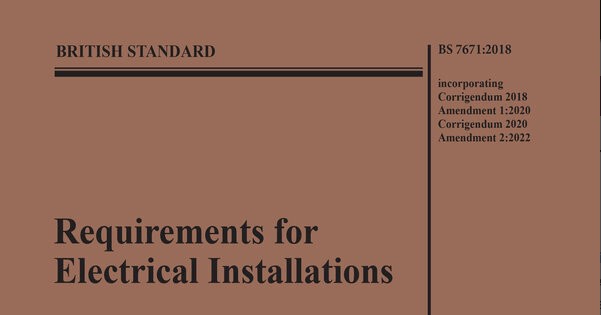18th Edition Amendment 2

In April this year Amendment 2 to BS7671:2018 was released. In this piece we are going to take a look at some of the changes that have taken place in a little more detail.
Before we do though, just a reminder, if you hold an 18th Edition qualification (i.e. City & Guilds 2382-18) there is no requirement for you to update that qualification. You just need to ensure you acquire a copy of the new regulations and make sure you are aware of the changes that have taken place. There is some overlap between the previous amendment and this one.
BS7671:2018+A1:2020 remains current and won’t be withdrawn until 27th September 2022. Until this point installations can be installed to either amendment 1 or amendment 2. From the 27th September onwards, all new electrical installations must be installed to amendment 2.
If you’re unsure where to find a concise list of changes, pages 8 through to 11 in BS7671 gives you an overview. We’re going to pick out a few to look at in a little more detail.

Chapter 42 Protection against thermal effects
Regulation 421.1.7 – The requirements for the installation of AFDD’s has started to tighten up. They SHALL be provided for single phase AC circuits supplying socket outlets rated at 32A or less in HMO’s, purpose built student accommodation, care homes and higher risk residential buildings (higher risk residential buildings are classed as buildings over 18m or height or in excess of six stories).
For other premises’ it is only RECOMMENDED that they be fitted. As an aside the cost on these is slowly coming down even if it is not yet at the point where many customers will be happy paying for them.

Section 514 Identification and notices
There is now an exception for domestic properties to omit some of the labels that used to be a requirement if certain conditions are met. Namely the following can be omitted:
– Periodic inspection and testing notice
– RCD six monthly test button operation notice
– Presence of SPD’s notice
To omit these there must be an up to date copy of the Electrical Installation Certificate, complete with the guidance for recipients present with the electrical installation.

Chapter 64 Initial Verification
RCD testing has seen a significant change. Regardless of the type of RCD utilised a test at its rated residual operating current shall be used. What this means in practice is where we used to test a 30mA RCD for example at 15, 30 and 150mA and record the slowest time it took to operate at 150mA, we now test it at 30mA (i.e. its rated residual operating current) and record that time.
Additional information has also been included on insulation resistance testing where there is equipment that is liable to be damaged when carrying out a test at 500V.
Related to inspection and testing, the model forms have seen a considerable shake up. Gone is the two-page schedule of inspections, which has been replaced with a simplified version. All elements of the previous schedule are still to be inspected where applicable, but instead of having an individual tick box each, they have been replaced with one tick box covering all elements of that particular section.
The schedule of test results has also changed. Whereas previously the circuit details and test results were all contained on the same sheet it has now been split into two separate sections, one for circuit details, one for test results.
The latest version of the IET model forms can be found here.

Chapter 82 Prosumer’s low-voltage electrical installation
A whole new chapter has been introduced. This is aimed at what BS761 calls the prosumers installation which it defines as:
“Low voltage electrical installations connected or not to a public distribution network able to operate:
– With local power supplies, and/or
– With local storage units
And that monitor and control the energy from the connected sources delivering it to:
– Current using equipment, and/or
– Local storage units, and/or
– Public distribution network”
This has been put into place to cater for the growing amount of alternative sources of electrical supply that are becoming more common place, such as battery storage or using an EV as a form of storage and supply.

Appendix 11 Warning and user instruction labels
A new appendix has been added collating all the warning and instructional labels used in an installation as well as providing guidance on details such as minimum font size for legibility.
In the main the changes to this amendment aren’t as large as in some previous edition/amendment changes. For more information on how these changes will physically affect your installations the IET have updated all their other publications in line with the new amendment of BS7671, giving you more specific guidance.
Guidance Note 3 in particular has seen a significant update and is a big improvement on previous versions. Guidance on the individual tests has been revised and updated and there is much more practical guidance on how to actually carry them out. The illustrations and diagrams have also been updated and make the point they are intended to describe much easier to understand.
Back to blog




